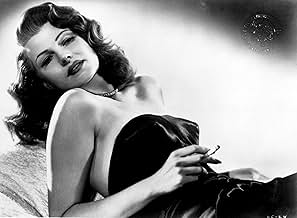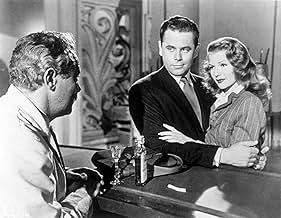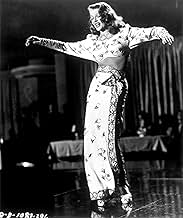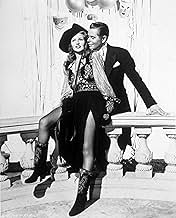Gilda
- 1946
- Tous publics
- 1h 50min
NOTE IMDb
7,6/10
38 k
MA NOTE
Un petit joueur engagé pour travailler dans un casino de Buenos Aires apprend que son ex a épousé son employeur.Un petit joueur engagé pour travailler dans un casino de Buenos Aires apprend que son ex a épousé son employeur.Un petit joueur engagé pour travailler dans un casino de Buenos Aires apprend que son ex a épousé son employeur.
- Réalisation
- Scénario
- Casting principal
- Récompenses
- 4 victoires et 1 nomination au total
Mark Roberts
- Gabe Evans
- (as Robert Scott)
Donald Douglas
- Thomas Langford
- (as Don Douglas)
Julio Abadía
- Newsman
- (non crédité)
- …
Enrique Acosta
- Gambler
- (non crédité)
Ed Agresti
- Nightclub Patron
- (non crédité)
Sam Appel
- Blackjack Dealer
- (non crédité)
Nina Bara
- Girl at Carnival
- (non crédité)
Edward Biby
- Gambler
- (non crédité)
Robert Board
- American Cartel Member
- (non crédité)
Avis à la une
Rita Hayworth positively sizzles as Gilda in this film-noir classic. From her initial hair-tossing scene to her near striptease while she sings "Put the Blame on Mame," Hayworth is captivating and more than convincing as the object of every man's desires. However, beyond the overtly heterosexual lures of Ms. Hayworth lurks a complex and ambiguous romantic triangle that provides more intrigue than the surface plot, which involves a gambling casino that is a front for shady operations that originated in a recently defeated, Fascist country.
Hayworth may either be the intruding wedge that comes between Glenn Ford and George Macready or the object of both men's romantic interests. From the initial meeting between Ford as two-bit gambler Johnny Farrell and Macready as Ballin Mundson the casino owner, an ambiguous, possibly homo-erotic, attraction is established between the two men. The lingering looks that they exchange can be read in several ways, but Bogie never looked into Cagney's eyes like Ford looks into Macready's. After Ford begins to work for Macready, his devoted care and slavish attention to his boss's needs exceed the bounds of employee and employer. When Hayworth moves into Macready's home as his new wife, Ford returns the key to the house as though he were a jilted lover. Ford's increasing jealousy becomes apparent after Hayworth's arrival on the scene, but it is unclear of whom he is jealous, Hayworth or Macready or possibly both. Perhaps Ford's character is as unsure of his own feelings as is the viewer, which makes the ambiguity even more intriguing. Macready's jealousy also grows as the heat between Ford and Hayworth intensifies, but, again, it is ambiguous of whom he is jealous.
With a dazzling performance by Hayworth, excellent black-and-white photography by Rudoph Mate, fine direction by Charles Vidor, and layers of psychological possibilities to ponder, "Gilda" is as golden as its title suggests.
Hayworth may either be the intruding wedge that comes between Glenn Ford and George Macready or the object of both men's romantic interests. From the initial meeting between Ford as two-bit gambler Johnny Farrell and Macready as Ballin Mundson the casino owner, an ambiguous, possibly homo-erotic, attraction is established between the two men. The lingering looks that they exchange can be read in several ways, but Bogie never looked into Cagney's eyes like Ford looks into Macready's. After Ford begins to work for Macready, his devoted care and slavish attention to his boss's needs exceed the bounds of employee and employer. When Hayworth moves into Macready's home as his new wife, Ford returns the key to the house as though he were a jilted lover. Ford's increasing jealousy becomes apparent after Hayworth's arrival on the scene, but it is unclear of whom he is jealous, Hayworth or Macready or possibly both. Perhaps Ford's character is as unsure of his own feelings as is the viewer, which makes the ambiguity even more intriguing. Macready's jealousy also grows as the heat between Ford and Hayworth intensifies, but, again, it is ambiguous of whom he is jealous.
With a dazzling performance by Hayworth, excellent black-and-white photography by Rudoph Mate, fine direction by Charles Vidor, and layers of psychological possibilities to ponder, "Gilda" is as golden as its title suggests.
Glenn Ford and Rita Hayworth made five films together, but when they are talked of as a screen team, it's only Gilda that people are really talking about. Their first film was before World War II, The Lady in Question where both are young Columbia contract players who were in the same film and no effort was made to bill them as a team. The Loves of Carmen which was made after Gilda was a disaster for Glenn Ford, though Rita was at her sexiest. Affair in Trinidad was a good effort to recapture the magic of Gilda after Rita's storm marriage to Aly Khan and the last film The Money Trap was a Glenn Ford film where Rita has a brief role as an old girl friend. She was the best thing in that film by far.
Do you remember in Cabaret how both the Liza Minnelli and Michael York characters find out they are sex partners to the same German bi-sexual man? That's essentially what happens in Gilda though with the Code firmly in place it's not something we talk about. George MacReady, a man of many interests rescues Glenn Ford from the docks of Buenos Aires after he's won some money from sailors in a crap game. They hit it off and Ford becomes his right hand man in running the casino MacReady operates.
Then MacReady brings home a wife and lo and behold it turns out to be an old girl friend of Ford's, Rita Hayworth. Add to that some Nazi refugees have some business with MacReady over some tungsten mines.
The real emphasis in this film is sex and personified by the best embodiment of sex ever on the silver screen. This film raked in a lot of dollars for Harry Cohn and Columbia Pictures. Hayworth, voice dubbed as usual, had a big number here in Put the Blame on Mame. It became a signature tune for her the rest of her life.
One thing did disappoint me about Gilda. For a story that took place in Buenos Aires who many say is the most beautiful city in the world, it would have been nice to see some location shots, even if it was just some newsreels to establish the time and place. The film might as well have been in Albuquerque.
But when you've got Rita to look at, it could be at the South Pole.
Do you remember in Cabaret how both the Liza Minnelli and Michael York characters find out they are sex partners to the same German bi-sexual man? That's essentially what happens in Gilda though with the Code firmly in place it's not something we talk about. George MacReady, a man of many interests rescues Glenn Ford from the docks of Buenos Aires after he's won some money from sailors in a crap game. They hit it off and Ford becomes his right hand man in running the casino MacReady operates.
Then MacReady brings home a wife and lo and behold it turns out to be an old girl friend of Ford's, Rita Hayworth. Add to that some Nazi refugees have some business with MacReady over some tungsten mines.
The real emphasis in this film is sex and personified by the best embodiment of sex ever on the silver screen. This film raked in a lot of dollars for Harry Cohn and Columbia Pictures. Hayworth, voice dubbed as usual, had a big number here in Put the Blame on Mame. It became a signature tune for her the rest of her life.
One thing did disappoint me about Gilda. For a story that took place in Buenos Aires who many say is the most beautiful city in the world, it would have been nice to see some location shots, even if it was just some newsreels to establish the time and place. The film might as well have been in Albuquerque.
But when you've got Rita to look at, it could be at the South Pole.
It's Rita Hayworth in probably her most memorable role. Her portrayal of Gilda is rightly remembered as a classic performance. But Gilda the character is much better than Gilda the movie. Hayworth may be a sensation but everything around her in this movie is not quite up to her standard. Not a bad movie by any means but no all-time classic either. It's one of those movies where a performance is remembered so fondly that perhaps people remember the movie as being somewhat better than it actually is. As good as Hayworth is she's not enough to hide the movie's flaws.
Our story unfolds in Buenos Aires. Which as you watch the movie is easy to forget because there is absolutely no South American flavor to the proceedings. The story might as well be set in Milwaukee. Anyhow small-time gambler and successful cheater Johnny Farrell somehow finds himself running a high-class casino after the casino's owner, Ballin Mundson, takes a liking to him. Everything is going swimmingly until one day, completely out of the blue, Ballin returns home from a trip with a beautiful new wife in tow. This woman is going to cause all kinds of complications. This woman of course is Gilda and right from the start, from her first memorable moment on the screen, Hayworth takes hold of the movie. Gilda's a fascinating character with so much lurking under the surface. And what's on the surface ain't so bad either. Not for nothing was Hayworth the era's most popular pinup girl. A shame then that the movie can't take full advantage of the allure and talents of its star.
Hayworth is vibrant, exciting, bursting with life. The movie is not. In playing Johnny Farrell, the character we unfortunately spend more time with than we do with Gilda, Glenn Ford comes across as being somewhat dull. And his character is rather unlikable. The story contains some elements which fall flat. There's something about a tungsten cartel which involves some angry Germans. This of course has nothing to do with Gilda. Can we just get back to Gilda? Please? Somewhere along the way the story really gets bogged down and not even Hayworth can fully rescue it. Everyone will remember Hayworth's big moments. She makes quite the impression with her famous singing and dancing. Well dancing anyway as the singing voice isn't hers. But nevertheless that famous number, "Put the Blame on Mame", is quite the spectacle. Now who to put the blame on for surrounding the fabulous Hayworth with an otherwise very ordinary movie? You'll love Rita. Love the movie? That's a stretch.
Our story unfolds in Buenos Aires. Which as you watch the movie is easy to forget because there is absolutely no South American flavor to the proceedings. The story might as well be set in Milwaukee. Anyhow small-time gambler and successful cheater Johnny Farrell somehow finds himself running a high-class casino after the casino's owner, Ballin Mundson, takes a liking to him. Everything is going swimmingly until one day, completely out of the blue, Ballin returns home from a trip with a beautiful new wife in tow. This woman is going to cause all kinds of complications. This woman of course is Gilda and right from the start, from her first memorable moment on the screen, Hayworth takes hold of the movie. Gilda's a fascinating character with so much lurking under the surface. And what's on the surface ain't so bad either. Not for nothing was Hayworth the era's most popular pinup girl. A shame then that the movie can't take full advantage of the allure and talents of its star.
Hayworth is vibrant, exciting, bursting with life. The movie is not. In playing Johnny Farrell, the character we unfortunately spend more time with than we do with Gilda, Glenn Ford comes across as being somewhat dull. And his character is rather unlikable. The story contains some elements which fall flat. There's something about a tungsten cartel which involves some angry Germans. This of course has nothing to do with Gilda. Can we just get back to Gilda? Please? Somewhere along the way the story really gets bogged down and not even Hayworth can fully rescue it. Everyone will remember Hayworth's big moments. She makes quite the impression with her famous singing and dancing. Well dancing anyway as the singing voice isn't hers. But nevertheless that famous number, "Put the Blame on Mame", is quite the spectacle. Now who to put the blame on for surrounding the fabulous Hayworth with an otherwise very ordinary movie? You'll love Rita. Love the movie? That's a stretch.
You could not have come up with a better title for this seductive thriller. GILDA is what this film is all about and Rita Hayworth is so engrossing and beautiful, you sometimes forget what is going on and just stare. "Put the Blame on Mame" is one of film history's more memorable singing sequences and we get to see it twice. Look out for the famous "hair-toss" scene the prisoners in SHAWSHANK REDEMPTION cheer at. There is a film to talk about here but the alluring Ms. Hayworth is always on the tip of your tongue.
Glenn Ford is the anti-hero of this excellent Noir portrait of double-crosses, jealousy, and forbidden love. He has many flaws, not the least being his infatuation of Gilda. Director Charles Vidor looked as though he was trying to capture a CASABLANCA-esque feel with the casino in Buenos Aires and people of all walks of life toiling within. There are even some familiar head nods at a roulette table. This is no CASABLANCA, but the end of WWII is somewhere in the backdrop and the stoic "Ballin Mundson", played by George Macready (PATHS OF GLORY), seems to have some foreign matters happening on the side, like "Victor Lazlo". The crisp black and white cinematography is effective, especially in the casino where 2/3 of the film takes place.
GILDA is all Hayworth and, whether you are a male or female viewer, you see a good performance. She is great to look at, but her dramatic scenes are equally great to see. GILDA is an all-time classic that ranks with MALTESE FALCON and DOUBLE INDEMNITY. Throughout the picture, the blame is put on Rita for most of the plot's turning points. There may just be someone as sweet as her flowing red hair inside waiting to come out. Glenn Fords' Johnny Farrel (perfect name for Noir character) cannot look past her deceiving flirtation and realize that the bad guy is right in front of him. Another triumphant film of the 1940's that works every time, GILDA is Rita Hayworth's claim to fame and sent her into the stratosphere as a star. She was more than just a pin-up.
RATING: 9 of 10
Glenn Ford is the anti-hero of this excellent Noir portrait of double-crosses, jealousy, and forbidden love. He has many flaws, not the least being his infatuation of Gilda. Director Charles Vidor looked as though he was trying to capture a CASABLANCA-esque feel with the casino in Buenos Aires and people of all walks of life toiling within. There are even some familiar head nods at a roulette table. This is no CASABLANCA, but the end of WWII is somewhere in the backdrop and the stoic "Ballin Mundson", played by George Macready (PATHS OF GLORY), seems to have some foreign matters happening on the side, like "Victor Lazlo". The crisp black and white cinematography is effective, especially in the casino where 2/3 of the film takes place.
GILDA is all Hayworth and, whether you are a male or female viewer, you see a good performance. She is great to look at, but her dramatic scenes are equally great to see. GILDA is an all-time classic that ranks with MALTESE FALCON and DOUBLE INDEMNITY. Throughout the picture, the blame is put on Rita for most of the plot's turning points. There may just be someone as sweet as her flowing red hair inside waiting to come out. Glenn Fords' Johnny Farrel (perfect name for Noir character) cannot look past her deceiving flirtation and realize that the bad guy is right in front of him. Another triumphant film of the 1940's that works every time, GILDA is Rita Hayworth's claim to fame and sent her into the stratosphere as a star. She was more than just a pin-up.
RATING: 9 of 10
The 40s and 50s produced many alluring performances from beautiful and sexy actresses and Rita Hayworth's in Gilda is one of the most provocative of all. The film is good and quite deep, the male leads are better, but Hayworth's performance is simply stunning and unforgettable. She may not have been the most beautiful 40s actress (Gene Tierney and Veronica Lake were more classic beauties imo), but if you look closely her ability to show the sweet, the vulnerable, and especially the wanton, in women has not been bettered. Somehow her character gets under the male viewer's skin in the same way as it does to the male characters in the film.
Modern film femme fatales are a pale shadow by comparison, for example Linda Fiorentino or Sharon Stone. I'm not sure why. It could be either that nowadays allure is too much equated with sex or nudity (less tantalising than several dashes of suggestion) or maybe it's that present day equivalents are portrayed as hard as nails without the necessary mix of sadness and vulnerability.
Whatever, if you've never appreciated what the appeal of 40s noir is, this is definitely one to try.
Modern film femme fatales are a pale shadow by comparison, for example Linda Fiorentino or Sharon Stone. I'm not sure why. It could be either that nowadays allure is too much equated with sex or nudity (less tantalising than several dashes of suggestion) or maybe it's that present day equivalents are portrayed as hard as nails without the necessary mix of sadness and vulnerability.
Whatever, if you've never appreciated what the appeal of 40s noir is, this is definitely one to try.
Le saviez-vous
- AnecdotesThere is a rumour that this film is the only time Rita Hayworth's real singing voice is heard, but that is not true. According to the bonus features from the DVD, Hayworth actually never recorded her own singing voice and was a talented lip-syncher. Anita Ellis dubbed almost all of her singing in this film. Hayworth always wanted to do her own singing, and Columbia Pictures chief Harry Cohn paid for her voice lessons, but she never developed a voice he considered strong enough to be used; Hayworth remained bitter about that for the rest of her life.
- GaffesWhen Farrell asks to cut the deck at the blackjack table, he shuffles the deck prior to the cut; this is not allowed.
- Citations
Gilda: You do hate me, don't you, Johnny?
Johnny Farrell: I don't think you have any idea of how much.
Gilda: Hate is a very exciting emotion. Haven't you noticed? Very exciting. I hate you too, Johnny. I hate you so much I think I'm going to die from it. Darling...
[they kiss passionately]
Gilda: I think I'm going to die from it.
- ConnexionsEdited into Head (1968)
Meilleurs choix
Connectez-vous pour évaluer et suivre la liste de favoris afin de recevoir des recommandations personnalisées
- How long is Gilda?Alimenté par Alexa
Détails
Box-office
- Montant brut mondial
- 5 999 $US
- Durée1 heure 50 minutes
- Couleur
- Rapport de forme
- 1.37 : 1
Contribuer à cette page
Suggérer une modification ou ajouter du contenu manquant




































